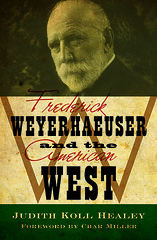Writing the Biography of Frederick Weyerhaeuser, 1834-1914
 Today’s post is by Judith Koll Healey, author of Frederick Weyerhaeuser and the American West. Weyerhaeuser was one of the great industrialists of the late nineteenth and early twentieth centuries and founder of the international timber corporation the Weyerhaeuser Company.
Today’s post is by Judith Koll Healey, author of Frederick Weyerhaeuser and the American West. Weyerhaeuser was one of the great industrialists of the late nineteenth and early twentieth centuries and founder of the international timber corporation the Weyerhaeuser Company.
Judith will be reading and signing at Common Good Books in St. Paul on Wednesday, June 5, at 7 p.m.
*****
Biography is the stepchild of history and the first cousin to fiction. The history is necessary for accuracy: the details of the times, the sights, the immediate background to set the scene. The reader has to enter the period with the writer as guide. Even more important, the writer must be as accurate about the subject’s life as possible. So the questions continually arise: What to put in? What to leave out? How to tell the honest story as closely to how it happened as possible?
But certain elements important to fiction must also inform the story. What was the main character like? How did he feel? What was he thinking in his youth that changed later in life? How was he with his family? His grandchildren? His tough-minded associates? Did he ever doubt himself? Was he generous or close fisted? Quick to decide or careful? The fiction writer must create these details that bring a character to life. The biographer must chase down the material that allows the honest creation of the character as a living human being, of interest to others.
We were fortunate in the Frederick Weyerhaeuser project to have an unprecedented amount of primary material from which to work. As the Weyerhaeuser family office moved from the First National Bank building in St. Paul, Minnesota, to a new space, many letters surfaced that had been long forgotten. Some were business letters, others far more personal. There were letters between Frederick and his wife Sarah when they were separated by his long winters in the Wisconsin forest. There were later letters to the sons, and the grandchildren.
And there were diaries from the early years in the long Wisconsin winters and later reflecting his anguish when his honor was challenged publicly by an associate who wanted a favor that Frederick refused to grant.
An astonishing and valuable cache of letters kept by one branch of the family was stored in multiple boxes in an attic at Woods Hole, Massachusetts. These were freely offered and the biographer was delighted. In those boxes rest a century of Americana, letters from the 1880s and 1890s that drew a fine picture of Frederick and Sarah’s later years through the correspondence of their daughter Margaret–who lived with them–and her husband Richard, who was teaching in a foreign land.
Even more wonderful were letters discovered in Saulheim, Germany, Frederick’s birth village. The family was given all of his letters, and those of the villagers in return make a composite picture of Frederick’s warm, funny, and personal relationship with his childhood friends and their now-grown children.
The Weyerhaeuser Company in Tacoma also had material, as did the Laird Norton group office in Seattle.
Finally, there was a remarkable resource created in the 1930s by Frederick and Sarah’s youngest son, also called Frederick but referred to in the family as F.E. This man, the youngest of the seven children, collected letters and recollections from many friends and associates of his father and put them into a five-volume work called A Record of the Life and Business Activities of Frederick Weyerhaeuser, 1834-1914. He added many of his own recollections, and there are many amusing anecdotes sprinkled among more serious stories and letters. In the interest of gentlemanly behavior of the times, some of the anecdotes involving others were crossed out in the work, apparently with the feeling that someone might take mild umbrage. An example is the description of Frederick’s brother-in-law and first partner, F.C.A. Denkmann, as having a “peppery disposition.” As the reader might imagine, these excised parts were among the more descriptive of the work and are a welcome resource to the later biographer. Many are included in this biography.
With this plethora of material and trips to east and west coast and eventually to Saulheim, Germany, to meet the descendants of Frederick’s childhood friends, a one-year project turned into four years. The result was satisfying. The book does its best to present a fascinating character in all of his stages, his business accomplishments and challenges and his family life.
This writer was grateful for the support of the family in opening archives and resources, in correcting my early misunderstandings of the differences among timber, logs, and lumber and, most of all, in never asking me to alter the text or remove personal anecdotes. This allowed me not only to get to know this fascinating nineteenth-century character but to draw freely a literary picture of him in this biography that is honest, accurate, and, in all of its humanity, real.



